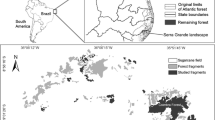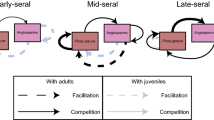Abstract
We summarize a long-term study of the effects of edge creation on establishment of the economically important arboreal palm Oenocarpus bacaba in an experimentally fragmented landscape in central Amazonia. Recruitment and mortality of large individuals (≥10 cm diameter-at-breast-height) were recorded within 21 1-ha plots in fragmented and intact forests for periods of up to 22 years. In addition, 12 small (0.7 × 14 m) sub-plots within each 1-ha plot were used to enumerate the abundance of seedlings and saplings (5–400 cm tall). On average, the recruitment of large trees was over two times faster near forest edges, leading to a sharp (90%) increase in the mean population density of large individuals near forest edges, whereas the density of larger trees remained constant in the forest interior. Overall seedling and sapling density was significantly lower in edge than interior plots, but edge plots had a much higher proportion of larger (>100 cm tall) saplings. Our findings demonstrate that forest edges can have complex effects on tree demography and that one must consider all tree life stages in order to effectively assess their effects on plant populations.



Similar content being viewed by others
References
Balick MJ (1986) The palm-tree of life: biology, utilization and conservation. Adv Econ Botany 6:1–282
Benitez-Malvido J (1998) Impact of forest fragmentation on seedling abundance in a tropical rain forest. Conserv Biol 12:380–389
Benitez-Malvido J, Garcia-Guzman G, Kossmann-Ferraz ID (1999) Leaf-fungal incidence and herbivory on tree seedling in tropical rainforest fragments: an experimental study. Biol Conserv 91:143–150
Benitez-Malvido J, Martinez-Ramos M (2003) Impact of forest fragmentation on understory plant species richness in Amazonia. Conserv Biol 17:389–400
Bruna EM (1999) Seed germination in rainforest fragments. Nature 402:139
Bruna EM (2002) Effects of forest fragmentation on Heliconia acuminate seedling recruitment in central Amazonia. Oecologia 132:235–243
Bruna EM, Kress WJ (2002) Habitat fragmentation and the demographic structure of an Amazonian understory herb (Heliconia acuminata). Conserv Biol 16:1256–1266
Cascante A, Quesada M, Lobo JJ, Funchs E (2002) Effects of dry tropical forest fragmentation on the reproductive success and genetic structure of the tree Samanea saman. Conserv Biol 16:137–147
Chacoff NP, Morales JM, Vaquera MP (2004) Efectos de la fragmentación sobre la aborción y depredación de semillas en el Chaco Serrano. Biotropica 36:109–117
Cintra R, Horna V (1997) Seed and seedling survival of the palm Astrocaryum murumuru and the legume Dipteryx micrantha in gaps in Amazonian forest. J Trop Ecol 13:257–277
Clark CJ, Poulsen JR, Parker VT (2001) The role of arboreal seed dispersal groups on the seed rain of a lowland tropical forest. Biotropica 33:606–620
Cordeiro NJ, Howe HF (2001) Low recruitment of trees dispersed by animals in African forest fragments. Conserv Biol 15:1733–1741
Cordeiro NJ, Howe HF (2003) Forest fragmentation severs mutualism between seed dispersed and an endemic African tree. Proc Natl Acad Sci 24:14052–14056
Cunningham SA (2000) Effects of habitat fragmentation on the reproductive ecology of four plant species in Mallee Woodland. Conserv Biol 14:758–768
Curran LM, Webb CO (2000) Experimental tests of the spatiotemporal scale of seed predation in mast-fruiting Dipterocarpaceae. Ecol Monogr 70:129–148
da Silva JMC, Tabarelli M (2000) Tree species impoverishment and the future flora of the Atlantic forest of northeast Brazil. Nature 404:72–74
Forget PM (1991) Scatterhoarding of Astrocaryum paramaca by Proechimys in French Guiana: comparison with Myoprocta exilis. J Trop Ecol 32:155–167
Galetti M, Donatti CI, Pires AS et al (2006) Seed survival and dispersal of an endemic Atlantic forest palm: the combined effects of defaunation and forest fragmentation. Bot J Linn Soc 151:141–149
Hammond DS (1995) Post-dispersal seed and seedling mortality of tropical dry forest trees after shifting agriculture, Chiapas, Mexico. J Trop Ecol 11:295–313
Hill JL, Curran PJ (2001) Species composition in fragmented forests: conservation implications of changing forest area. Appl Geogr 21:157–174
Howe HF, Miriti M (2004) When seed dispersal matters. Bioscience 54:651–660
Howe HF, Smallwood J (1982) Ecology of seed dispersal. Ann Rev Ecol Syst 13:201–228
Janzen DH (1971) The fate of Scheelea rostrata fruits beneath the parent tree: predispersal attack by bruchids. Principles 15:89–101
Janzen DH (1986) The future of tropical biology. Ann Rev Ecol Syst 17:305–324
Kapos V (1989) Effects of isolation on the water status of forest patches in the Brazilian Amazon. J Trop Ecol 5:173–185
Küchmeister H, Webber AC, Silberbauer-Gottsberger I et al (1998) A polinização e sua relação com a termogênese em espécies de Arecaceae e Annonaceae da Amazônia Central. Acta Amazonica 28:217–245
Laurance WF, Ferreira LV, Rankin-de Merona JM et al (1998a) Rain forest fragmentation and the dynamics of Amazonian tree communities. Ecology 79:2032–2040
Laurance WF, Ferreira LV, Rankin-de Merona JM et al (1998b) Effects of forest fragmentation on recruitment patterns in Amazonian tree communities. Conserv Biol 12:460–464
Laurance WF, Lovejoy TE, Vasconcelos HL et al (2002) Ecosystem decay of Amazonian forest fragments: a 22-year investigation. Conserv Biol 16:605–618
Laurance WF, Nascimento HEM, Laurance SG et al (2004) Inferred longevity of Amazonian rainforest trees based on a long-term demographic study. For Ecol Manag 190:131–143
Laurance WF, Nascimento HEM, Laurance SG et al (2006a) Rain forest fragmentation and the proliferation of successional trees. Ecology 87:469–482
Laurance WF, Nascimento HEM, Laurance SG et al (2006b) Rapid decay of tree-community composition in Amazonian forest fragments. Proc Natl Acad Sci 103:19010–19014
Lepsch-Cunha N (2003) Efeitos da fragmentação do habitat e do desmatamento no sucesso reprodutivo de uma palmeira amazônica: Oenocarpus bacaba Martius. PhD Thesis, INPA/UFAM
Lovejoy TE, Bierregaard RO, Rylands AB et al (1986) Edge and other effects of isolation on Amazon forest fragments. In: Soulé ME (ed) Conservation biology: the science of scarcity and diversity. Sinauer Associates, Massachusetts
Melo FPL, Dirzo R, Tabarelli M (2006) Biased seed rain in forest edges: evidence from the Brazilian Atlantic forest. Biol Conserv 132:50–60
Nascimento HEM, Laurance WF (2002) Total aboveground biomass in central Amazonian rainforests: a landscape-scale study. For Ecol Manag 168:311–321
Oliveira AA, Mori SA (1999) A central Amazonian terra-firme forest. I. High tree species richness on poor soils. Biodivers Conserv 8:1219–1244
Oliveira MA, Grillo AS, Tabarelli M (2004) Forest edge in the Brazilian Atlantic forest: drastic changes in tree species assemblages. Oryx 38:389–394
Pimentel DS, Tabarelli M (2004) Seed dispersal of the palm Attalea oleifera in a remnant of the Brazilian Atlantic forest. Biotropica 36:74–84
Rankin-de-Merona JM, Prance GT, Hutchings RW et al (1992) Preliminary results of a large-scale inventory of upland rain forest in the Central Amazon. Acta Amazonica 22:493–534
SAS Institute Inc. (1999) SAS statistical software. SAS Institute Inc., Cary, North Carolina
Scariot AO (1999) Forest fragmentation effects on palm diversity in Central Amazonia. J Ecol 87:67–76
Silva MG, Tabarelli M (2001) Seed dispersal, plant recruitment and spatial distribution of Bactris acanthocarpa Martius (Arecaceae) in a remnant of Atlantic forest in northeast Brazil. Acta Oecologica 22:259–268
Tabarelli M, Mantovani W, Peres CA (1999) Effects of habitat fragmentation on plant guild structure in the montane Atlantic forest of southeastern Brazil. Biol Conserv 91:119–127
Tilman D, May RM, Lehman CL et al (1994) Habitat destruction and the extinction debt. Nature 371:65–66
Turner IM, Chua KSY, Soong BC et al (1996) A century of plant species loss from an isolated fragment of lowland tropical rain forest. Conserv Biol 10:1129–1244
Uhl C (1987) Factors controlling succession following slash-and-burn agriculture in Amazonia. J Ecol 75:377–407
Wright SJ, Zeballos H, Dominguez I et al (2000) Poachers alter mammal abundance, seed dispersal, and seed predation in a neotropical forest. Conserv Biol 14:227–239
Zaminelli JC (2006) Efeitos da fragmentação florestal sobre a dinâmica de dispersão de Oenocarpus bacaba Mart. (Arecaceae). Dissertation, INPA/UFAM
Acknowledgments
The manuscript was greatly improved by reviews from B. Nomann, M. Sandrini, M. Da Costa, J. Narita, and an anonymous referee. E. Hooper allowed us to collect data in her study sub-plots. Support was provided by the NASA/LBA Program; Programa Piloto para Proteção das Florestas Tropicais (PPG-7); A. W. Mellon Foundation; Conservation, Food, and Health Foundation; World Wildlife Fund-U.S.; MacArthur Foundation; National Institute for Amazonian Research (INPA); Fundação de Amaparo à Pesquisa do Amazonas (FAPEAM); Conselho Nacional de Desenvolvimento Científico e Tecnológico (CNPq); and Smithsonian Institution (SI). This is the publication number 509 in the BDFFP Technical Series.
Author information
Authors and Affiliations
Corresponding author
Rights and permissions
About this article
Cite this article
Brum, H.D., Nascimento, H.E.M., Laurance, W.F. et al. Rainforest fragmentation and the demography of the economically important palm Oenocarpus bacaba in central Amazonia. Plant Ecol 199, 209–215 (2008). https://doi.org/10.1007/s11258-008-9425-y
Received:
Accepted:
Published:
Issue Date:
DOI: https://doi.org/10.1007/s11258-008-9425-y




